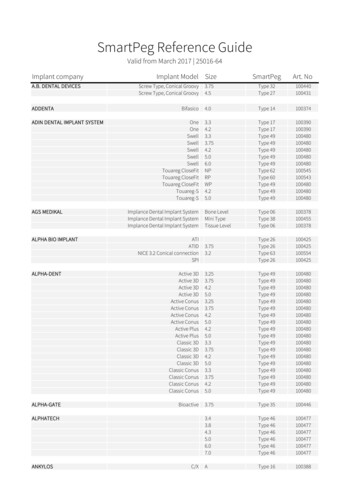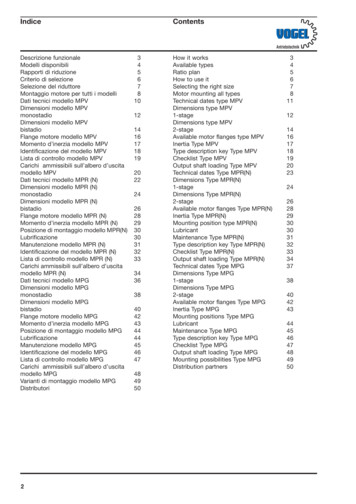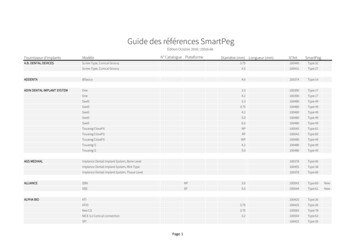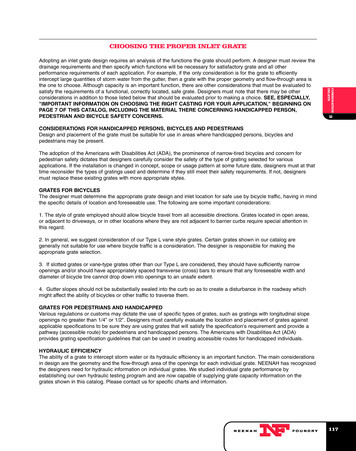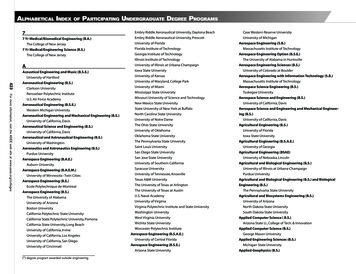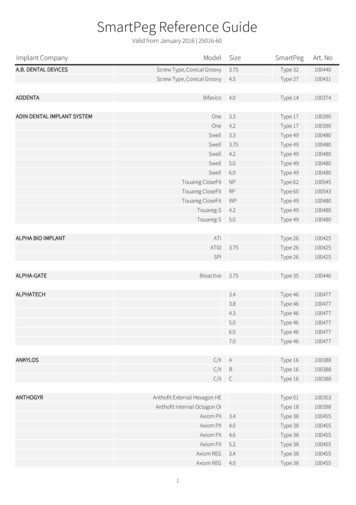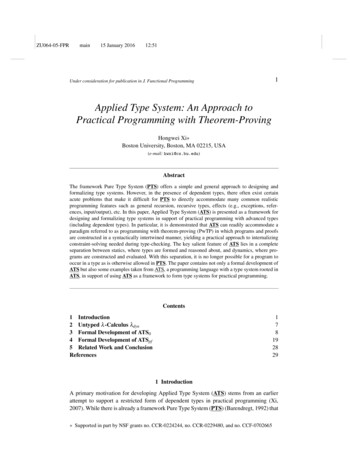
Transcription
ZU064-05-FPRmain15 January 201612:51Under consideration for publication in J. Functional Programming1Applied Type System: An Approach toPractical Programming with Theorem-ProvingHongwei Xi Boston University, Boston, MA 02215, USA(e-mail: hwxi@cs.bu.edu)AbstractThe framework Pure Type System (PTS) offers a simple and general approach to designing andformalizing type systems. However, in the presence of dependent types, there often exist certainacute problems that make it difficult for PTS to directly accommodate many common realisticprogramming features such as general recursion, recursive types, effects (e.g., exceptions, references, input/output), etc. In this paper, Applied Type System (ATS) is presented as a framework fordesigning and formalizing type systems in support of practical programming with advanced types(including dependent types). In particular, it is demonstrated that ATS can readily accommodate aparadigm referred to as programming with theorem-proving (PwTP) in which programs and proofsare constructed in a syntactically intertwined manner, yielding a practical approach to internalizingconstraint-solving needed during type-checking. The key salient feature of ATS lies in a completeseparation between statics, where types are formed and reasoned about, and dynamics, where programs are constructed and evaluated. With this separation, it is no longer possible for a program tooccur in a type as is otherwise allowed in PTS. The paper contains not only a formal development ofATS but also some examples taken from ATS, a programming language with a type system rooted inATS, in support of using ATS as a framework to form type systems for practical programming.Contents1 Introduction2 Untyped λ -Calculus λdyn3 Formal Development of ATS04 Formal Development of ATSpf5 Related Work and ConclusionReferences1781928291 IntroductionA primary motivation for developing Applied Type System (ATS) stems from an earlierattempt to support a restricted form of dependent types in practical programming (Xi,2007). While there is already a framework Pure Type System (PTS) (Barendregt, 1992) that Supported in part by NSF grants no. CCR-0224244, no. CCR-0229480, and no. CCF-0702665
ZU064-05-FPRmain215 January 201612:51Hongwei Xioffers a simple and general approach to designing and formalizing type systems, it is wellunderstood that there often exist some acute problems (in the presence of dependent types)making it difficult for PTS to accommodate many common realistic programming features.In particular, various studies reported in the literature indicate that great efforts are oftenrequired in order to maintain a style of pure reasoning as is advocated in PTS when featuressuch as general recursion (Constable & Smith, 1987), recursive types (Mendler, 1987),effects (Honsell et al., 1995), exceptions (Hayashi & Nakano, 1988) and input/output arepresent.The framework ATS is formulated to allow for designing and formalizing type systemsthat can readily support common realistic programming features. The formulation of ATSgiven in this paper is primarily based on the work reported in two previous papers (Xi,2004; Chen & Xi, 2005) but there are some fundamental changes in terms of the handlingof proofs and proof construction. In particular, the requirement is dropped that a proof inATS must be represented as a normalizing lambda-term (Xi, 2008a).In contrast to PTS, the key salient feature of ATS lies in a complete separation betweenstatics, where types are formed and reasoned about, from dynamics, where programs areconstructed and evaluated. This separation, with its origin in a previous study on a restricted form of dependent types developed in Dependent ML (DML) (Xi, 2007), makes itstraightforward to support dependent types in the presence of effects such as references andexceptions. Also, with the introduction of two new (and thus somewhat unfamiliar) formsof types: guarded types and asserting types, ATS is able to capture program invariants ina manner that is similar to the use of pre-conditions and post-conditions (Hoare, 1969).By now, studies have shown amply and convincingly that a variety of traditional programming paradigms (e.g., functional programming, object-oriented programming, metaprogramming, modular programming) can be directly supported in ATS without relying onad hoc extensions, attesting to the expressiveness of ATS. In this paper, the primary focusof study is set on a novel programming paradigm referred to as programming with theoremproving (PwTP) and its support in ATS. In particular, a type-theoretical foundation forPwTP is to be formally established and its correctness proven.The notion of type equality plays a pivotal rôle in type system design. However, theimportance of this rôle is often less evident in commonly studied type systems. For instance, in the simply typed λ -calculus, two types are considered equal if and only if theyare syntactically the same; in the second-order polymorphic λ -calculus (λ2 ) (Reynolds,1972) and System F (Girard, 1986), two types are considered equal if and only if they areα-equivalent; in the higher-order polymorphic λ -calculus (λω ), two types are consideredequal if and only if they are β η-equivalent. This situation immediately changes in ATS,and let us see a simple example that stresses this point.In Figure 1, the presented code implements a function in ATS (Xi, 2008b), which isa substantial system such that its compiler alone currently consists of more than 165Klines of code implemented in ATS itself.1 The concrete syntax used in the implementationshould be accessible to those who are familiar with Standard ML (SML) (Milner et al.,1997)). Note that ATS is a programming language equipped with a type system rooted in1Please see http://www.ats-lang.org for more details.
ZU064-05-FPRmain15 January 201612:51Journal of Functional Programming3funappend{a:type}{m,n:nat}(xs: list (a, m), ys: list (a, n)) : list (a, m n) case xs of nil() ys (* the first clause *) cons(x, xs) cons (x, append(xs, ys)) (* the second clause *)// end of [append]Fig. 1. List-append in ATSATS, and the name of ATS derives from that of ATS. The type constructor list takes twoarguments; when applied to a type T and an integer I, list(T, I) forms a type for lists oflength I in which each element is of type T . Also, the two list constructors nil and consare assigned the following types:nilcons:: a : type. () list(a, 0) a : type. n : nat. (a, list(a, n)) list(a, n 1)So nil constructs a list of length 0, and cons takes an element and a list of length n toform a list of length n 1. The header of the function append indicates that append isassigned the following type: a : type. m : nat. n : nat. (list(a, m), list(a, n)) list(a, m n)which simply means that append returns a list of length m n when applied to one list oflength m and another list of length n. Note that type is a built-in sort in ATS, and a staticterm of the sort type stands for a type (for dynamic terms). Also, int is a built-in sort forintegers in ATS, and nat is the subset sort {a : int a 0} for all nonnegative integers.When the above implementation of append is type-checked, the following two constraints are generated:1. m : nat. n : nat. m 0 n m n2. m : nat. n : nat. m0 : nat. m m0 1 (m0 n) 1 m nThe first constraint is generated when the first clause is type-checked, which is needed fordetermining whether the types list(a, n) and list(a, m n) are equal under the assumption that list(a, m) equals list(a, 0). Similarly, the second constraint is generated whenthe second clause is type-checked, which is needed for determining whether the typeslist(a, (m0 n) 1) and list(a, m n) are equal under the assumption that list(a, m) equalslist(a, m0 1). Clearly, certain restrictions need to be imposed on the form of constraintsallowed in practice so that an effective approach can be found to perform constraintsolving. In DML, a programming language based on DML (Xi, 2007), the constraintsgenerated during type-checking are required to be linear inequalities on integers so thatthe problem of constraint satisfaction can be turned into the problem of linear integerprogramming, for which there are many highly practical solvers (albeit the problem oflinear integer programming itself is NP-complete). This is indeed a very simple design, but
ZU064-05-FPRmain15 January 201612:514Hongwei Xiit can also be too restrictive, sometimes, as nonlinear constraints (e.g., n : int.n n 0) arecommonly encountered in practice. Furthermore, the very nature of such a design indicatesits being inherently ad hoc.By combining programming with theorem-proving, a fundamentally different design ofconstraint-solving can provide the programmer with an option to handle nonlinear constraints through explicit proof construction. For the sake of a simpler presentation, let usassume for this moment that even the addition function on integers cannot appear in theconstraints generated during type-checking. Under such a restriction, it is still possible toimplement a list-append function in ATS that is assigned a type capturing the invariant thatthe length of the concatenation of two given lists xs and ys equals m n if xs and ys areof length m and n, respectively. Let us first see such an implementation given in Figure 2,which is presented here as a motivating example for programming with theorem-proving(PwTP).The datatypes Z and S are declared in Figure 2 solely for representing natural numbers:Z represents 0, and S(N) represents the successor of the natural number represented by N.The data constructors associated with Z and S are of no use. Given a type T and anothertype N, mylist(T, N) is a type for lists containing n elements of the type T , where n isthe natural number represented by N. Note that mylist is not a standard datatype (as issupported in ML); it is a guarded recursive datatype (GRDT) (Xi et al., 2003), which isalso known as generalized algebraic datatype (GADT) (Cheney & Hinze, 2003) in Haskelland OCaml. The datatype addrel is declared to capture the relation induced by the additionfunction on natural numbers. Given types M, N, and R representing natural numbers m,n, and r, respectively, the type addrel(M, N, R) is for a value representing some proofof m n r. Note that addrel is also a GRDT or GADT. There are two constructorsaddrel z and addrel s associated with addrel, which encode the following two rules:0 n(m 1) n n (m n) 1for every natural number nfor every pair of natural numbers m and nLet us now take a look at the implementation of myappend. Formally, the type assignedto myappend can be written as follows: a : type. m : type. n : type.(mylist(a, m), mylist(a, n)) r : type. (addrel(m, n, r), mylist(a, r))In essence, this type states the following: Given two lists of length m and n, myappendreturns a pair such that the first component of the pair is a proof showing that m n equalsr for some natural number r and the second component is a list of length r.Unlike append, type-checking myappend does not generate any linear constraints onintegers. As a matter of fact, myappend can be readily implemented in both Haskell andOCaml (extended with support for generalized algebraic datatypes), where there is nobuilt-in support for handling linear constraints on integers. This is an example of greatsignificance in the sense that it demonstrates concretely an approach to allowing the programmer to write code of the nature of theorem-proving so as to simplify or even eliminatecertain constraints that need otherwise to be solved directly during type-checking. Withthis approach, constraint-solving is effectively internalized, and the programmer can ac-
ZU064-05-FPRmain15 January 201612:51Journal of Functional Programming5datatype Z() Z of ()datatype S(a:type) S of a//datatypemylist(type, type) {a:type}mynil(a, Z()) {a:type}{n:type}mycons(a, S(n)) of (a, mylist(a, n))//datatypeaddrel(type, type, type) {n:type}addrel z(Z(), n, n) of () {m,n:type}{r:type}addrel s(S(m), n, S(r)) of addrel(m, n, r)//funmyappend{a:type}{m,n:type}(xs: mylist(a, m), ys: mylist(a, n)) : [r:type](addrel(m, n, r), mylist(a, r)) (case xs of mynil() letval pf addrel z() in (pf, ys)end // end of [mynil] mycons(x, xs) letval (pf, res) myappend(xs, ys) in (addrel s(pf), mycons(x, res))end // end of [mycons])Fig. 2. A motivating example for PwTP in ATStively participate in constraint simplification, gaining a tight control in determining whatconstraints should be passed to the underlying constraint-solver.There are some major issues with the implementation given in Figure 2. Clearly, representing natural numbers as types is inadequate since there are types that do not representany natural numbers. More seriously, this representation turns quantification over naturalnumbers (which is predicative) into quantification over types (which is impredicative),causing unnecessary complications. Also, proof construction (that is, construction of values of types formed by addrel) needs to be actually performed at run-time, which causesinefficiency both time-wise and memory-wise. Probably the most important issue is thatproof validity is not guaranteed. For instance, it is entirely possible to fake proof construction by making use of non-terminating functions.
ZU064-05-FPRmain615 January 201612:51Hongwei Xidatasortmynat Z of () S of mynat//datatypemylist(type, mynat) {a:type}mynil(a, Z()) {a:type}{n:mynat}mycons(a, S(n)) of (a, mylist(a, n))//datapropaddrel(mynat, mynat, mynat) {y:mynat}addrel z(Z, y, y) of () {x,y:mynat}{r:mynat}addrel s(S(x), y, S(r)) of addrel(x, y, r)//funmyappend{a:type}{m,n:mynat}(xs: mylist(a, m), ys: mylist(a, n)) : [r:mynat](addrel(m, n, r) mylist(a, r)) (case xs of mynil() letval pf addrel z() in (pf ys)end // end of [mynil] mycons(x, xs) letval (pf res) myappend(xs, ys) in (addrel s(pf) mycons(x, res))end // end of [mycons])Fig. 3. An example making use of PwTP in ATSIn Figure 3, another implementation of myappend is given that makes use of the supportfor PwTP in ATS. Instead of representing natural numbers as types, a datasort of thename mynat is declared and natural numbers can be represented as static terms of thesort mynat. Also, a dataprop addrel is declared for capturing the relation induced bythe addition function on natural numbers. As a dataprop, addrel can only form typesfor values representing proofs, which are erased after type-checking and thus need noconstruction at run-time. In the implementation of myappend, the bar symbol ( ) is used inplace of the comma symbol to separate components in tuples; the components appearingto the left of the bar symbol are proof expressions (to be erased) and those to the rightare dynamic expressions (to be evaluated). After proof-erasure, the implementation ofmyappend essentially matches that of append given in Figure 1.
ZU064-05-FPRmain15 January 201612:51Journal of Functional Programming7As a framework to facilitate the design and formalization of advanced type systems forpractical programming, ATS is first formulated with no support for PwTP (Xi, 2004). Thisformulation is the basis for a type system referred to as ATS0 in this paper. The support forPwTP is added into ATS in a subsequent formulation (Chen & Xi, 2005), which serves asthe basis for a type system referred to as ATSpf in this paper. However, a fundamentallydifferent approach is adopted in ATSpf to justify the soundness of PwTP, which essentiallytranslates each well-typed program in ATSpf into another well-typed one in ATS0 of thesame dynamic semantics. The identification and formalization of this approach, which isboth simpler and more general than one used previously (Chen & Xi, 2005), consists of amajor technical contribution of the paper.It is intended that the paper should focus on the theoretical development of ATS, andthe presentation given is of a minimalist style. The organization for the rest of the paper isgiven as follows. An untyped λ -calculus λdyn is first presented in Section 2 for the purposeof introducing some basic concepts needed to formally assign dynamic (that, operational)semantics to programs. In Section 3, a generic applied type system ATS0 is formulated andits type-soundness established. Subsequently, ATS0 is extended to ATSpf in Section 4 withsupport for PwTP, and the type-soundness of ATSpf is reduced to that of ATS0 througha translation from well-typed programs in the former to those in the latter. Lastly, someclosely related work is discussed in Section 5 and the paper concludes.2 Untyped λ -Calculus λdynThe purpose of formulating λdyn , an untyped lambda-calculus extended with constants (including constant constructors and constant functions), is to set up some machinery neededto formalize dynamic (that is, operational) semantics for programs. It is to be proven that awell-typed program in ATS can be turned into one in λdyn through type-erasure and prooferasure while retaining its dynamic semantics, stressing the point that types and proofs inATS play no active rôle in the evaluation of a program. In this regard, the form of typingstudied in ATS is of Curry-style (in contrast with Church-style) (Reynolds, 1998).There are no static terms in λdyn . The syntax for the dynamic terms in λdyn is given asfollows:dynamic terms e:: x dcx( e) he1 , e2 i fst(e) snd(e) lam x.e app(e1 , e2 ) let x e1 in e2where the notation e is for a possibly empty sequence of dynamic terms. Let dcx rangeover external dynamic constants, which include both dynamic constructors dcc and dynamic functions dcf . The arguments taken by a dynamic constructor or function are oftenprimitive values (instead of those constructed by lam and h·, ·i) and the result returned byit is often a primitive value as well. The meaning of various forms of dynamic terms shouldbecome clear when the rules for evaluating them are given.The values in λdyn are just special forms of dynamic terms, and the syntax for them isgiven as follows:valuesv:: x dcc( v) hv1 , v2 i lam x.e
ZU064-05-FPRmain15 January 2016812:51Hongwei Xiwhere v is for a possibly empty sequence of values. A standard approach to assigningdynamic semantics to terms is based on the notion of evaluation contexts:evaluation contexts E:: [] dcx(v1 , . . . , vi 1 , E, ei 1 , . . . , en ) hE, ei hv, Ei app(E, e) app(v, E) let x E in eEssentially, an evaluation context E is a dynamic term in which a subterm is replaced witha hole denoted by []. Note that only subterms at certain positions in a dynamic term can bereplaced to form valid evaluation contexts.Definition 2.1The redexes in λdyn and their reducts are defined as follows: fst(hv1 , v2 i) is a redex, and its reduct is v1 .snd(hv1 , v2 i) is a redex, and its reduct is v2 .app(lam x.e, v) is a redex, and its reduct is e[x 7 v].dcf ( v) is a redex if it is defined to equal some value v; if so, its reduct is v.Note that it may happen later that a new form of redex can have more than one reducts.Given a dynamic term of the form E[e1 ] for some redex e1 , E[e1 ] is said to reduce to E[e2 ]in one-step if e2 is a reduct of e1 , and this one-step reduction is denoted by E[e1 ] E[e2 ].Let stand for the reflexive and transitive closure of .Given a program (that is, a closed dynamic term) e0 in λdyn , a finite reduction sequencestarting from e0 can either lead to a value or a non-value. If a non-value cannot be furtherreduced, then the non-value is said to be stuck or in a stuck form. In practice, values canoften be represented in special manners to allow various stuck forms to be detected throughchecks performed at run-time. For instance, the representation of a value in a dynamicallytyped language most likely contains a tag to indicate the type of the value. If it is detectedthat the evaluation of a program reaches a stuck form, then the evaluation can be terminatedabnormally with a raised exception.Detecting potential stuck forms that may occur during the evaluation of a program canalso be done statically (that is, at compiler-time). One often imposes a type discipline toensure the absence of various stuck forms during the evaluation of a well-typed program.This is the line of study to be carried out in the rest of the paper.3 Formal Development of ATS0As a generic applied type system, ATS0 consists of a static component (statics), wheretypes are formed and reasoned about, and a dynamic component (dynamics), where programs are constructed and evaluated. The statics itself is a simply typed lambda-calculus(extended with certain constants), and the types in it are called sorts so as to avoid confusion with the types for classifying dynamic terms, which are themselves static terms.The syntax for the statics of ATS0 is given in Figure 4. Let b range over the base sortsin ATS0 , which include at least bool for static booleans and type for types (assigned todynamic terms). The base sort int for static integers is not really needed for formalizingATS0 but it is often used in the presented examples. Let a and s range over static variablesand static terms, respectively. There may be some built-in static constants scx, which areeither static constant constructors scc or static constant functions scf. A c-sort is of the
ZU064-05-FPRmain15 January 201612:51Journal of Functional Programmingsortsstatic termsstatic var. ctx.static subst.σsΣΘ:: :: :: :: 9b σ1 σ2a scx(s1 , . . . , sn ) λ a : σ .s s1 (s2 )0/ Σ, a : σ[] Θ[a 7 s]Fig. 4. The syntax for the statics of ATS0form (σ1 , . . . , σn ) b, which can only be assigned to static constants. Note that a c-sortis not considered a (regular) sort. Given a static constant scx, a static term scx(s1 , . . . , sn )is of sort b if scx is assigned a c-sort (σ1 , . . . , σn ) b for some sorts σ1 , . . . , σn and si canbe assigned the sorts σi for i 1, . . . , n. It is allowed to write scc for scc() if there is norisk of confusion. In ATS0 , the existence of the following static constants with the assignedc-sorts is assumed:true : () boolfalse : () bool ty : (type, type) bool : (type, type) type : (type, type) type : (bool, type) type : (bool, type) type σ: (σ type) type σ: (σ type) typeNote that infix notation may be used for certain static constants. For instance, s1 s2stands for (s1 , s2 ) and s1 ty s2 stands for ty (s1 , s2 ). In addition, a : σ .s and a : σ .sstand for σ (λ a : σ .s) and σ (λ a : σ .s), respectively. Given a static constant constructorscc, if the c-sort assigned to scc is (σ1 , . . . , σn ) type for some sorts σ1 , . . . , σn , then scc isa type constructor. For instance, , , , , σ and σ are all type constructors. Additionalbuilt-in base type constructors may be assumed.Given a proposition B and a type T , B T is a guarded type and B T is an assertingtype. Intuitively, if a value v is assigned a guarded type B T , then v can be used only ifthe guard B is satisfied; if a value v of an asserting type B T is generated at a programpoint, then the assertion B holds at that point. For instance, suppose that int is a sort for(static) integers and int is a type constructor of the sort (int) type; given a static terms of the sort int, int(s) is a singleton type for the integer equal to s; hence, the usual typeInt for (dynamic) integers can be defined as a : int. int(a), and the type Nat for naturalnumbers can be defined as a : int. (a 0) int(a). Moreover, the following type is forthe (dynamic) division function on integers: a1 : int. a2 : int. a2 6 0 (int(a1 ), int(a2 )) int(a1 /a2 )where the meaning of 6 and / should be obvious. With such a type, division by zero isdisallowed during type-checking (at compile-time). Also, suppose that bool is a type constructor of the sort (bool) type such that for each proposition B, bool(B) is a singletontype for the truth value equal to B. Then the usual type Bool for (dynamic) booleans canbe defined as a : bool. bool(a). The following type is an interesting one: a : bool. bool(a) a 1
ZU064-05-FPRmain1015 January 201612:51Hongwei XiΣ(a) σ(st-var)Σ a:σ scx : (σ1 , . . . , σn ) b Σ s1 : σ1 · · · Σ sn : σn(st-scx)Σ scx(s1 , . . . , sn ) : bΣ, a : σ1 s : σ2(st-lam)Σ λ a : σ1 .s : σ1 σ2Σ s1 : σ1 σ2 Σ s2 : σ1(st-app)Σ s1 (s2 ) : σ2Fig. 5. The sorting rules for the statics of ATS0where 1 stands for the unit type. Given a function f of this type, we can apply f to aboolean value v of type bool(B) for some proposition B; if f (v) returns, the B must be true;therefore f acts like dynamic assertion-checking.For those familiar with qualified types (Jones, 1994), which underlies the type classmechanism in Haskell, it should be noted that a qualified type cannot be regarded as aguarded type. The simple reason is that the proof of a guard in ATS0 bears no computationalsignificance, that is, it cannot affect the run-time behavior of a program, while a dictionary,which is just a proof of some predicate on types in the setting of qualified types, can and ismostly likely to affect the run-time behavior of a program.The standard rules for assigning sorts to static terms are given in Figure 5, where thejudgement scx : (σ1 , . . . , σn ) b means that the static constant scx is assumed to be ofthe c-sort (σ1 , . . . , σn ) b. Given s s1 , . . . , sn and σ σ1 , . . . , σn , a judgement of theform Σ s : σ means Σ si : σi for i 1, . . . , n. Let B stand for a static term that can beassigned the sort bool (under some context Σ) and B a possibly empty sequence of staticboolean terms. Also, let T stand for a type (for dynamic terms), which is a static termthat can be assigned the sort type (under some context Σ). Given contexts Σ1 and Σ2 anda substitution Θ, the judgement Σ1 Θ : Σ2 means that Σ1 Θ(a) : Σ2 (a) is derivable foreach a dom(Θ) dom(Σ2 ).Proposition 3.1Assume Σ s : σ is derivable. If Σ Σ1 , Σ2 and Σ1 Θ : Σ2 holds, then Σ1 s[Θ] : σ isderivable.ProofBy structural induction on the derivation of Σ s : σ .Definition 3.1 (Constraints in ATS0 )A constraint in ATS0 is of the form Σ; B B0 , where Σ B : bool holds for each B in B andΣ B0 : bool holds as well, and the constraint relation in ATS0 is the one that determineswhether each constraint is true or false.Each regularity rule in Figure 6 is assumed to be met, that is, the conclusion of eachregularity rule holds if all of its premisses hold, and the following regularity conditions on ty are also satisfied:1. Σ; B T ty T holds for every T .
ZU064-05-FPRmain15 January 201612:51Journal of Functional Programming11B B(reg-id)Σ; B BΣ; B true(reg-true)Σ; B false(reg-false)Σ; B BΣ; B B(reg-var-thin)Σ, a : σ ; B BΣ B1 : bool Σ; B B2(reg-bool-thin)Σ; B, B1 B2Σ, a : σ ; B B Σ s : σ(reg-subst)Σ; B[a 7 s] B[a 7 s]Σ; B B1Σ; B, B1 B2Σ; B B2(reg-cut)Fig. 6. The regularity rules for the constraint relation in ATS0dynamic termse:: dynamic valuesv:: dynamic var. ctx. :: x dcx{ s}(e1 , . . . , en ) he1 , e2 i fst(e) snd(e) lam x. e app(e1 , e2 ) (e) (e) slam a. e sapp(e, s) (e) let (x) e1 in e2 hs, ei let ha, xi e1 in e2x dcc{ s}(v1 , . . . , vn ) hv1 , v2 i lam x. e (e) slam a. e (v) hs, vi0/ , x : Tdynamic subst.Θ:: [] Θ[x 7 e]Fig. 7. The syntax for the dynamics in ATS02.3.4.5.6.7.8.9.Σ; B T ty T 0 and Σ; B T 0 ty T 00 implies Σ; B T ty T 00 .Σ; B T1 T2 ty T10 T20 implies Σ; B T1 ty T10 and Σ; B T2 ty T20 .Σ; B T1 T2 ty T10 T20 implies Σ; B T10 ty T1 and Σ; B T2 ty T20 .Σ; B B T ty B0 T 0 implies Σ; B, B B0 and Σ; B, B T ty T 0 .Σ; B B T ty B0 T 0 implies Σ; B, B0 B and Σ; B, B0 T ty T 0 .Σ; B a : σ .T ty a : σ .T 0 implies Σ, a : σ ; B T ty T 0 .Σ; B a : σ .T ty a : σ .T 0 implies Σ, a : σ ; B T ty T 0 .0;/ 0/ scc(T1 , . . . , Tn ) ty T 0 implies T 0 scc(T10 , . . . , Tn0 ) for some T10 , . . . , Tn0 .The need for these conditions is to become clear when proofs are constructed in thefollowing presentation for formally establishing various meta-properties of ATS0 . For instance, the last of the above conditions can be invoked to make the claim that T 0 ty T1 T2 implies T 0 being of the form T10 T20 . Note that this condition actually implies theconsistency of the constraint relation as not every constraint is valid.Let us now move onto the dynamic component (dynamics) of ATS0 . The syntax forthe dynamics of ATS0 is given in Figure 7. Let x range over dynamic variables and dcx
ZU064-05-FPRmain15 January 201612:5112Hongwei Xidynamic constants, which include both dynamic constant constructors dcc and dynamicconstant functions dcf . Some (unfamiliar) forms of dynamic terms are to be understoodwhen the rules for assigning types to them are presented. Let v range over values, whichare dynamic terms of certain special forms, and range over dynamic variable contexts,which assign types to dynamic variables.During the formal development of ATS0 , proofs are often constructed by induction onderivations (represented as trees). Given a judgement J, D :: J means that D is a derivationof J, that is, the conclusion of D is J. Given a derivation D, ht(D) stands for the height ofthe tree that represents D.In ATS0 , a typing judgement is of the form Σ; B; e : T , and the rules for deriving sucha judgement are given in Figure 8. Note that certain obvious side conditions associated withsome of the typing rules are omitted for the sake of brevity. For instance, the variable a isnot allowed to have free occurrences in B, , or T when the rule (ty- -intr) is applied.Given B B1 , . . . , Bn , B T stands for B1 (
also known as generalized algebraic datatype (GADT) (Cheney & Hinze, 2003) in Haskell and OCaml. The datatype addrelis declared to capture the relation induced by the addition function on natural numbers. Given types M, N, and R representing natural numbers m, n, and r, respectively, the type addrel(M;N;R) is for a value representing some proof
